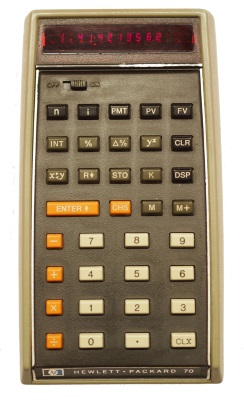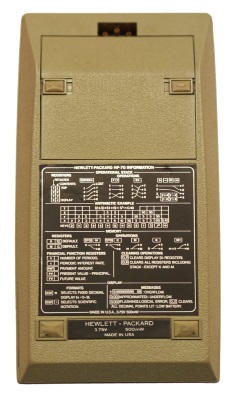| HP codename, series |
unknown, Classic.
|
| Type, Precision, Input mode |
Business, 13 BCD digits, exponent ±99, Reverse Polish Notation |
| Programmable |
No
|
| Performance
Index |
-
|
| Memory |
2 registers M and K, not permanent |
| Display |
13 digit 7 segment red LED plus sign |
| Special features |
2 memory locations M and K. K powers up with the value of 12.
|
| Original Pricing, Production |
$275, 1974 - 1975
|
| Batteries |
3x AA battery pack equipped with 1.5V rechargeable
or normal batteries.
|
| Dimensions |
Length 15.1cm, Width 8cm, Height 3.6cm |
| Links |
HP-70 Owner's Handbook, PDF, 125 pages, English, July 1974
HP-70 Demonstration Book, PDF, 17 pages, English, unknown release date
|
| Comment |
The HP-70 was a cheaper version of the more powerful HP-80.
It had a very short life and was quickly replaced by the cheaper and
more powerful HP-22. Only relatively few HP-70 units were sold and as a
result they are rare, and nowadays difficult and expensive to get.
|
| Explanation of financial function keys.
To reset all values to 0 press "CLR"
n
|
Number of payment and interest periods
|
i
|
Periodic interest rate in percent
|
PMT
|
Payment amount per period, may be negative or 0
|
PV
|
Present amount at beginning of first period
|
FV
|
Future amount, after n periods of payments and compound interest
|
Pressing "DSP" and one of the above keys shows the current value of the associated variable.
To enter a value for a variable, key in the number and press the associated button.
To calculate a value press the
desired button without entering a number. Based on the numbers stored
in the other four variables, the solution is calculated.
Example:
- Press "CLR"
- 5% interest rate: Press 5 and "i"
- Start value of $1000: Press 1000 and "PV"
- Final value of $5000: Press 5000 and "FV"
- Press "n" to calculate the number of periods needed reach the final value: 32.99
|

